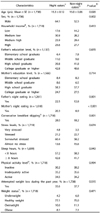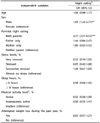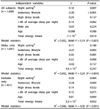1. Laurson KR, Lee JA, Eisenmann JC. The cumulative impact of physical activity, sleep duration, and television time on adolescent obesity: 2011 Youth Risk Behavior Survey. J Phys Act Health. 2015; 12:355–360.

2. Wang Y, Lobstein T. Worldwide trends in childhood overweight and obesity. Int J Pediatr Obes. 2006; 1:11–25.

3. Statistics Korea. The obesity rates of children and adolescents [Internet]. Daejeon: Statistics Korea;2015. cited 2015 April 15. Available from:
http://www.index.go.kr.
4. Kim HS, Park J, Ma Y, Ham OK. Factors influencing health-related quality of life of overweight and obese children in South Korea. J Sch Nurs. 2013; 29:361–369.

5. Song Y, Park MJ, Paik HY, Joung H. Secular trends in dietary patterns and obesity-related risk factors in Korean adolescents aged 10-19 years. Int J Obes (Lond). 2010; 34:48–56.

6. Almoosawi S, Prynne CJ, Hardy R, Stephen AM. Time-of-day and nutrient composition of eating occasions: prospective association with the metabolic syndrome in the 1946 British birth cohort. Int J Obes (Lond). 2013; 37:725–731.

7. Huang CJ, Hu HT, Fan YC, Liao YM, Tsai PS. Associations of breakfast skipping with obesity and health-related quality of life: evidence from a national survey in Taiwan. Int J Obes (Lond). 2010; 34:720–725.

8. Deshmukh-Taskar P, Nicklas TA, Radcliffe JD, O'Neil CE, Liu Y. The relationship of breakfast skipping and type of breakfast consumed with overweight/obesity, abdominal obesity, other cardiometabolic risk factors and the metabolic syndrome in young adults. The National Health and Nutrition Examination Survey (NHANES): 1999-2006. Public Health Nutr. 2013; 16:2073–2082.

9. Niemeier HM, Raynor HA, Lloyd-Richardson EE, Rogers ML, Wing RR. Fast food consumption and breakfast skipping: predictors of weight gain from adolescence to adulthood in a nationally representative sample. J Adolesc Health. 2006; 39:842–849.

10. Gallant A, Lundgren J, Drapeau V. Nutritional aspects of late eating and night eating. Curr Obes Rep. 2014; 3:101–107.

11. Cho YJ, Kim MH, Kim MH, Choi MK. Night eating habits of middle school students in Gyeonggi. J Korean Soc Food Sci Nutr. 2014; 43:300–308.

12. Baron KG, Reid KJ, Kern AS, Zee PC. Role of sleep timing in caloric intake and BMI. Obesity (Silver Spring). 2011; 19:1374–1381.

13. Huang Y. Night eating in Hong Kong adolescents: prevalence and associations with dinner habits, bedtime and weight status [master's thesis]. Hong Kong: The University of Hong Kong;2014.
14. Lamerz A, Kuepper-Nybelen J, Bruning N, Wehle C, Trost-Brinkhues G, Brenner H, Hebebrand J, Herpertz-Dahlmann B. Prevalence of obesity, binge eating, and night eating in a cross-sectional field survey of 6-year-old children and their parents in a German urban population. J Child Psychol Psychiatry. 2005; 46:385–393.

15. Striegel-Moore RH, Franko DL, Thompson D, Affenito S, Kraemer HC. Night eating: prevalence and demographic correlates. Obesity (Silver Spring). 2006; 14:139–147.

16. Suh Y, Lee EK, Chung YJ. Comparison of nutritional status by energy level of night snack in Korean adults: using the data from 2005 Korean National Health and Nutrition Examination Survey. Korean J Nutr. 2012; 45:479–488.

17. Jung HJ, Park KH, Cho YG, Cho JJ, Paek YJ, Song HJ, Byun JS. Night eating tendency and related health risk factors. Korean J Obes. 2006; 15:98–105.
18. Hong SH, Yeon JY, Bae YJ. Relationship among night eating and nutrient intakes status in university students. J East Asian Soc Diet Life. 2013; 23:297–310.
19. Joung HS, Koo NS. The dietary and Late-night eating behavior according to residence type of university students in Daejeon. Korean J Hum Ecol. 2014; 23:721–732.

20. Jun YS, Choi MK, Bae YJ. Night eating and nutrient intake status according to residence type in university students. J Korean Soc Food Sci Nutr. 2015; 44:216–225.

21. Striegel-Moore RH, Franko DL, May A, Ach E, Thompson D, Hook JM. Should night eating syndrome be included in the DSM? Int J Eat Disord. 2006; 39:544–549.

22. Energy and Protein Requirements. Report of a joint FAO/WHO/UNU expert consultation. World Health Organ Tech Rep Ser. 1985; 724:1–206.
23. The Korean Nutrition Society. Dietary Reference Intakes for Koreans. Seoul: The Korean Nutrition Society;2010.
24. Madden JP, Goodman SJ, Guthrie HA. Validity of the 24-hr. recall. Analysis of data obtained from elderly subjects. J Am Diet Assoc. 1976; 68:143–147.
25. Kant AK, Block G, Schatzkin A, Ziegler RG, Nestle M. Dietary diversity in the US population, NHANES II, 1976-1980. J Am Diet Assoc. 1991; 91:1526–1531.

26. Kant AK, Schatzkin A, Ziegler RG. Dietary diversity and subsequent cause-specific mortality in the NHANES I epidemiologic follow-up study. J Am Coll Nutr. 1995; 14:233–238.

27. Preedy VR. Handbook of Anthropometry: Physical Measures of Human Form in Health and Disease. New York (NY): Springer-Verlag;2012.
28. Korea Centers for Disease Control and Prevention. Korean Pediatrics Society. 2007 Korea Growth Charts. Cheongwon: Korea Centers for Disease Control and Prevention;2007.
29. Colles SL, Dixon JB, O'Brien PE. Night eating syndrome and nocturnal snacking: association with obesity, binge eating and psychological distress. Int J Obes (Lond). 2007; 31:1722–1730.

30. Ochiai H, Shirasawa T, Ohtsu T, Nishimura R, Morimoto A, Hoshino H, Tajima N. Eating behaviors and overweight among adolescents: a population-based survey in Japan. J Obes. 2013; 2013:717942.

31. Klesges RC, Stein RJ, Eck LH, Isbell TR, Klesges LM. Parental influence on food selection in young children and its relationships to childhood obesity. Am J Clin Nutr. 1991; 53:859–864.

32. Allison KC, Lundgren JD, O'Reardon JP, Geliebter A, Gluck ME, Vinai P, Mitchell JE, Schenck CH, Howell MJ, Crow SJ, Engel S, Latzer Y, Tzischinsky O, Mahowald MW, Stunkard AJ. Proposed diagnostic criteria for night eating syndrome. Int J Eat Disord. 2010; 43:241–247.

33. de Zwaan M, Roerig DB, Crosby RD, Karaz S, Mitchell JE. Nighttime eating: a descriptive study. Int J Eat Disord. 2006; 39:224–232.

34. Almoosawi S, Winter J, Prynne CJ, Hardy R, Stephen AM. Daily profiles of energy and nutrient intakes: are eating profiles changing over time? Eur J Clin Nutr. 2012; 66:678–686.

35. LeGates TA, Fernandez DC, Hattar S. Light as a central modulator of circadian rhythms, sleep and affect. Nat Rev Neurosci. 2014; 15:443–454.

36. Wyse CA, Biello SM, Gill JM. The bright-nights and dim-days of the urban photoperiod: implications for circadian rhythmicity, metabolism and obesity. Ann Med. 2014; 46:253–263.

37. Gallant AR, Mathieu ME, Lundgren JD, Allison K, Tremblay A, O'Loughlin J, Drapeau V. Daily physical activity patterns of children with delayed eating behaviors. J Biol Rhythms. 2013; 28:332–338.

38. Striegel-Moore RH, Rosselli F, Wilson GT, Perrin N, Harvey K, DeBar L. Nocturnal eating: association with binge eating, obesity, and psychological distress. Int J Eat Disord. 2010; 43:520–526.

39. Allison KC, Goel N, Ahima RS. Delayed timing of eating: impact on weight and metabolism. Curr Obes Rep. 2014; 3:91–100.

40. Dattilo M, Crispim CA, Zimberg IZ, Tufik S, de Mello MT. Meal distribution across the day and its relationship with body composition. Biol Rhythm Res. 2010; 42:119–129.

41. Hibi M, Masumoto A, Naito Y, Kiuchi K, Yoshimoto Y, Matsumoto M, Katashima M, Oka J, Ikemoto S. Nighttime snacking reduces whole body fat oxidation and increases LDL cholesterol in healthy young women. Am J Physiol Regul Integr Comp Physiol. 2013; 304:R94–R101.

42. Spaeth AM, Dinges DF, Goel N. Effects of experimental sleep restriction on weight gain, caloric intake, and meal timing in healthy adults. Sleep. 2013; 36:981–990.

43. Korea Centers for Disease Control and Prevention. 2007 Statistics on Adolescent Health-related Behavior in South Korea. Cheongwon: Korea Centers for Disease Control and Prevention;2008.
44. Park S. Association between short sleep duration and obesity among South korean adolescents. West J Nurs Res. 2011; 33:207–223.

45. Yeh SS, Brown RF. Disordered eating partly mediates the relationship between poor sleep quality and high body mass index. Eat Behav. 2014; 15:291–297.

46. Arble DM, Bass J, Laposky AD, Vitaterna MH, Turek FW. Circadian timing of food intake contributes to weight gain. Obesity (Silver Spring). 2009; 17:2100–2102.

47. Andersen GS, Stunkard AJ, Sørensen TI, Petersen L, Heitmann BL. Night eating and weight change in middle-aged men and women. Int J Obes Relat Metab Disord. 2004; 28:1338–1343.

48. Roenneberg T, Kuehnle T, Pramstaller PP, Ricken J, Havel M, Guth A, Merrow M. A marker for the end of adolescence. Curr Biol. 2004; 14:R1038–R1039.

49. Meule A, Allison KC, Brähler E, de Zwaan M. The association between night eating and body mass depends on age. Eat Behav. 2014; 15:683–685.










 PDF
PDF ePub
ePub Citation
Citation Print
Print



 XML Download
XML Download